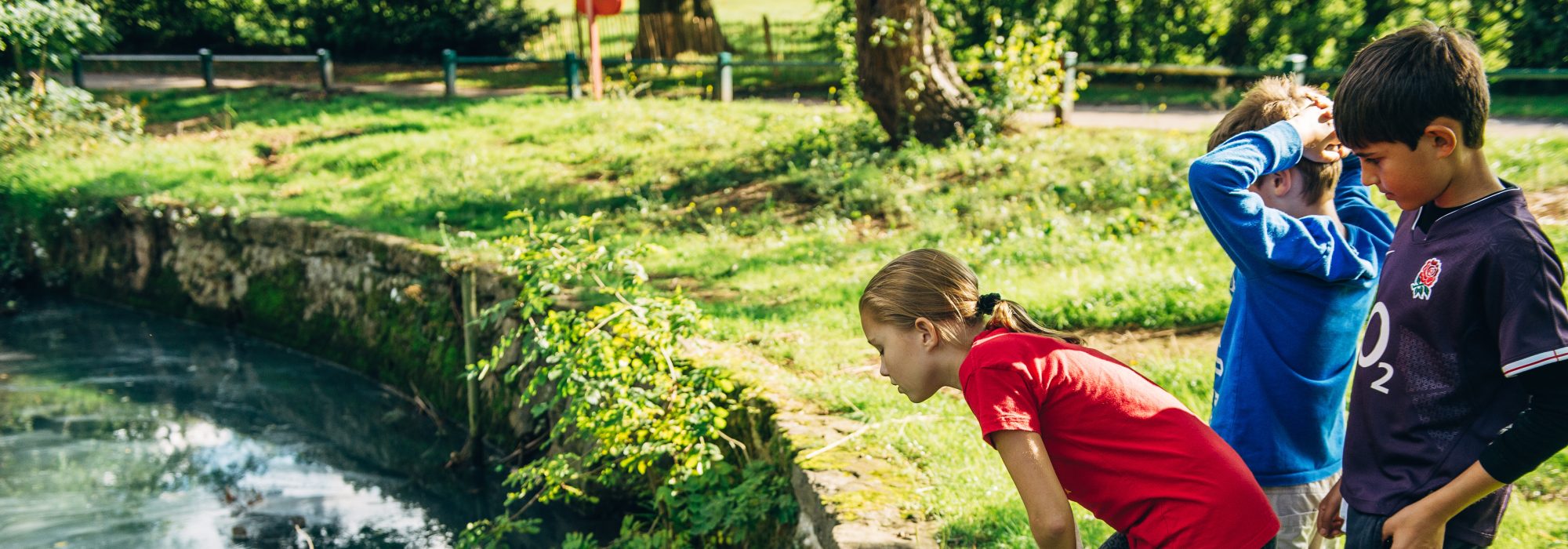Salmons Brook SuDS
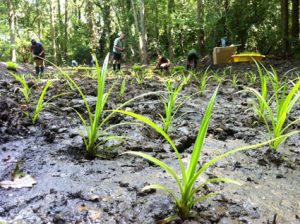 Thames21 has been working with Enfield Council, The Environment Agency and Thames Water to improve the health of the Salmons Brook using systems inspired by nature and the energy of local people who live close to the river.
Thames21 has been working with Enfield Council, The Environment Agency and Thames Water to improve the health of the Salmons Brook using systems inspired by nature and the energy of local people who live close to the river.
View real time water quality monitoring of the Glenbrook wetland system!
Why the Salmons Brook?
The Salmons Brook starts near Potters Bar and flows through Enfield to join the River Lea in Edmonton. The Salmons Brook is failing standards for water quality set out by the EU and needs new approaches to help clean it up.
Enfield has a separate sewage system, meaning that surface water and wastewater are carried in two separate pipes. As a result, pollutants enters the Salmons Brook in a number of different ways, through misconnected plumbing, road run-off and dumping of household and industrial waste into surface water drains.
What are the aims of the project?
This project consists of a number of key elements:
1. Creating a range of wetland systems to help treat polluted water before it is allowed to enter the Salmons Brook
2. Promoting local behavioral change through education about the urban water cycle
3. Allowing more people to access and benefit from their local waterways and wetland systems
4. Assessing the impact of the wetlands created and of local behavioral change on the health of the Salmons Brook
Wetland systems
Wetland systems known as Sustainable Drainage Systems (SuDS) have been created to treat polluted water that flows through the drainage network and into the river. In urban areas, road run-off (including oil and heavy metals) are washed into the river every time it rains. As well as filtering pollutants out of water, SuDS can also help reduce local flood risk by slowing the flow, create wildlife habitats and provide new amenities for local people.
This great animation by Susdrain shows how SuDS work.
Below are the different wetland systems we’ve created as part of the Salmons Brook Healthy River Challenge:
Houndsden Spinney SuDS
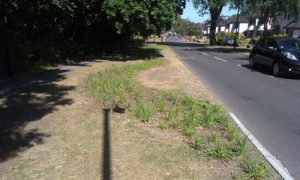 These SuDS have been designed to treat water that runs off Houndsden Road every time it rains. Run-off is directed along the verge in a shallow ditch (known as a swale) and into the natural woodland basin of the Spinney, where chemicals which would pollute the river are naturally and safely used by plants to grow or broken down by bacteria in the soil.
These SuDS have been designed to treat water that runs off Houndsden Road every time it rains. Run-off is directed along the verge in a shallow ditch (known as a swale) and into the natural woodland basin of the Spinney, where chemicals which would pollute the river are naturally and safely used by plants to grow or broken down by bacteria in the soil.
Grovelands Park SuDS
 A wetland system has been created here to filter water that runs off Branscombe Gardens and Seaforth Gardens, before it is allowed to enter Grovelands Park stream and in turn the Salmons Brook. Two rocky outfalls bring surface water pipes above ground and direct water through shallow ditches into the wetland treatment basin.
A wetland system has been created here to filter water that runs off Branscombe Gardens and Seaforth Gardens, before it is allowed to enter Grovelands Park stream and in turn the Salmons Brook. Two rocky outfalls bring surface water pipes above ground and direct water through shallow ditches into the wetland treatment basin.
Grovelands Park Reed Bed
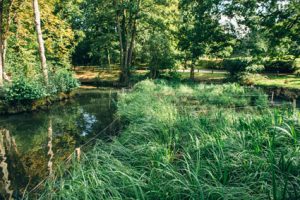 Reedbeds are another type of wetland system. Here you can see a reed bed we’ve created in Grovelands Park lake. This 200m² reedbed filters water which enters from a large network of surface water drains before it flows out into the lake and eventually joins the Salmons Brook.
Reedbeds are another type of wetland system. Here you can see a reed bed we’ve created in Grovelands Park lake. This 200m² reedbed filters water which enters from a large network of surface water drains before it flows out into the lake and eventually joins the Salmons Brook.
Glenbrook Integrated Wetlands
 When the Glenbrook (a river which feeds the Salmons Brook) first emerges above ground it is already badly polluted. Wetlands have been created here to filter pollutants from the stream which is directed through a series of six linked treatment basins.
When the Glenbrook (a river which feeds the Salmons Brook) first emerges above ground it is already badly polluted. Wetlands have been created here to filter pollutants from the stream which is directed through a series of six linked treatment basins.
Thanks to the Environment Agency – who supplied the equipment – you can watch real time water quality monitoring data on the Glenbrook here. We’ll be analysing this data to see the impact of the Glenbrook Rainscape.
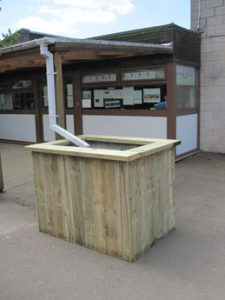 Rain Planters
Rain Planters
Mini SuDS or ‘wetland boxes’ take water from roofs and help slow the flow of water into surface water drains. We have delivered these Rain Planters to schools close to the Salmons Brook to educate young people about the benefits of wetlands and to help reduce local flood risk.
Education and promoting behavioural change
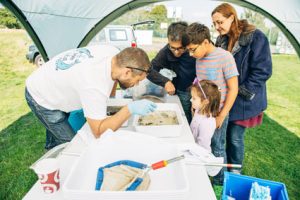 Our Love the Lea educational programme has been active around key locations across Enfield, to engage young people with the issues and inspire them with solutions. Local river celebration events across the catchment have engaged new audiences by giving people the opportunity to explore and better understand their local river environments.
Our Love the Lea educational programme has been active around key locations across Enfield, to engage young people with the issues and inspire them with solutions. Local river celebration events across the catchment have engaged new audiences by giving people the opportunity to explore and better understand their local river environments.
Drain Marking
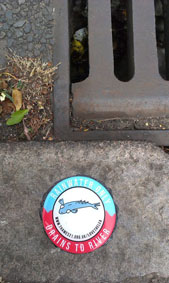 Through drain marking we aim to raise further awareness among the general public that surface water drains lead straight to local rivers. Knowing this can help change people’s attitude towards dumping waste such as cooking oil, paint and other household detergents down the drain, and ensure they check their household plumbing is properly connected
Through drain marking we aim to raise further awareness among the general public that surface water drains lead straight to local rivers. Knowing this can help change people’s attitude towards dumping waste such as cooking oil, paint and other household detergents down the drain, and ensure they check their household plumbing is properly connected
Plumbing misconnections are another major source of pollution in areas with separate sewage networks, like the Salmons Brook catchment. As part of this project, we have been working with Thames Water to help raise awareness among home owners to stop household waste from entering the river in this way. For more information on how to identify, prevent and fix plumbing misconnections, click here
Access to waterways for everyone
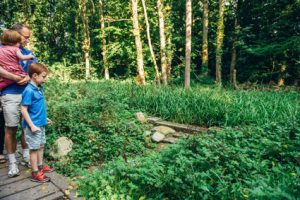 Alongside delivering wetland schemes, we are improving access to waterways so more people can benefit from their local streams and wetlands.
Alongside delivering wetland schemes, we are improving access to waterways so more people can benefit from their local streams and wetlands.
Monitoring the success of this project
Over the course of this project, we have been monitoring the impact of our work on the health of the Salmons Brook in a number of ways.
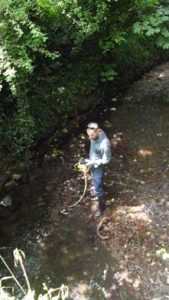 Water quality testing
Water quality testing
To test how well our wetlands filter and break down harmful pollutants we have been studying changes in water chemistry in our field lab. Comparing water quality in local waterways over time can tell us how effectively the wetland schemes are working. We are in the process of compiling a report to share our findings which will be publically available when it’s complete.
Inverterbrate surveys
To study the improved potential of the river habit, we have carried out a number of invertebrates surveys around our project sites.
For more information about this project or to get involved, please contact John Bryden at john.bryden@thames21.org.uk.
Links:
Real time water quality monitoring of the Glenbrook 2017
Salmons Brook water sampling assessment May 2016
Monitoring of sustainable drainage in Salmons Brook Catchment
